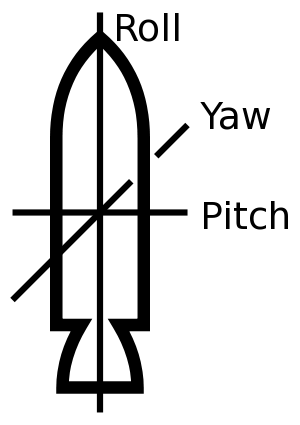Axis/ru
An axis is an imaginary line around which an object can rotate. A three-dimensional object such as a spacecraft has three noteworthy axes, corresponding to each dimension of space. Rotation is produced by torque. In reality, torque is the product of a linear force and its distance from the axis. In KSP, there are four ways to produce torque, each with its own limitations and side effects:
- "Magic torque", produced by capsule/rus, probe/ru bodies and reaction wheel/ru. This is a twisting force - in any axis - applied at the location of whatever component provides it, with no other effects; it gets less effective further from the centre of mass.
- Control surface/rus in atmosphere. Each control surface can only produce torque in one axis, but (by default) the game can figure out how to map control inputs to control surface actuations to produce the requested rotation.
- Thrust vectoring/ru, produced by a gimbaled engine. This can't produce rotation in the axis parallel to the engine's thrust (i.e. roll), and obviously only works while the engine is firing.
- Any linear force applied at a distance from the center of mass, at an angle away from it. This is how RCS/ru produces torque, but any net force can produce torque this way. In particular, unevenly placed boosters and drag-producing components can lead to a net force on one side, producing torque.
The mass distribution of the craft affects how torque produces rotation. In general, the further away from the axis a mass is, the more torque is needed to move it around the axis at a particular rate. Most rockets are long and narrow; so rolling is easy, but yawing and pitching are hard. RCS enhances rotation by exploiting lever effects: the further the thrust is applied from the centre of mass, the larger the torque it produces.
By default the viewpoint of rotating is from the command module first added, so the described movements here are only the default cases. It is possible to change the viewpoint of rotation to another component. To do so right-click a part and select “Control from here”. Only command modules and docking ports support this option and it will rotate always around the center of mass/ru, not around the selected part.
Тангаж
Тангаж (англ. "Pitch"). Тангажирование - перемещает нос вверх или вниз, а хвост - в противоположном направлении. Ось расположена от левого до правого борта через центр массы. Для поворота длинного или высокого летательного аппарата по оси тангажа, необходим больший вращающий момент; ширина не влияет на тангажирование.
Крен
Крен (англ. "Roll") - это поворот вокруг оси, расположенной от носа до хвостовой части. Для поворота широкого или высокого летательного аппарата по оси крена, необходим больший вращающий момент; длина не влияет на вращение по крену. Большинству длиннейших аппаратов, легче всего выполнять маневры по крену, чем по другим размерностям.
Рыскание
Рыскание (англ. "Yaw") - движение вокруг оси крена перемещает нос к левому или правому борту, а хвост - в противоположном направлении. Ось расположена по направлению сверху вниз через центр масс. Для поворота широкого или длинного летательного аппарата по оси рыскания, необходим больший вращающий момент; высота (т.е. размер от верха до низа) не влияет на вращение по оси рыскания.
Aircraft tend to be wider than they are tall and longer than they are wide. This makes rolling the easiest rotation, followed by pitching, while yaw is the hardest rotation for an aircraft. With this in mind, it is usually more effective to turn by rolling in the desired direction, then pitching up. With the right wing configuration, an aircraft in a rolled attitude is also subject to a yawing torque, which is especially efficient for slow turns.
